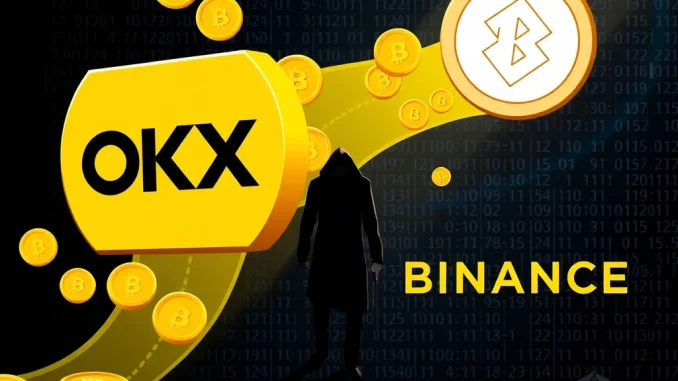
In a shocking turn of events that has sent ripples through the cryptocurrency community, recent reports have surfaced linking the funds used in the Hyperliquid JELLY attack to major cryptocurrency exchanges, OKX and Binance. This revelation, initially brought to light by on-chain analytics platform LookOnChain via X (formerly Twitter), has ignited a fresh wave of discussions and concerns regarding exchange security and fund traceability in the decentralized finance (DeFi) space. Let’s dive into the details of this developing story and understand its potential implications for the crypto world.
Unveiling the Source: How Were Crypto Funds Traced to OKX & Binance?
LookOnChain, a prominent blockchain analytics firm, played a crucial role in uncovering the origins of the funds used in the Hyperliquid JELLY attack. By meticulously tracking on-chain transactions, they were able to trace the flow of cryptocurrency from the attacker’s wallet back to withdrawals originating from well-known exchange platforms, specifically OKX and Binance. This process involves analyzing the transaction history on the blockchain, following the digital trail of the funds as they move from one wallet to another.
Here’s a simplified breakdown of how on-chain analysis works in such cases:
- Transaction Monitoring: Blockchain explorers and analytical tools continuously monitor transactions occurring on the blockchain, recording details such as sender addresses, receiver addresses, and the amount of cryptocurrency transferred.
- Address Clustering: Analysts use sophisticated techniques to group related addresses together, often based on transaction patterns and shared origins. This helps in identifying entities controlling multiple addresses.
- Exchange Identification: Known deposit and withdrawal patterns associated with cryptocurrency exchanges are used to identify when funds move to or from exchange-related wallets. Exchanges often use identifiable address patterns or are tagged in blockchain explorers.
- Tracing the Flow: By following the transaction trail backward from the attacker’s wallet, analysts can identify the source of funds, which in this case led back to withdrawals from OKX and Binance.
This capability of tracing cryptocurrency transactions is a double-edged sword. While it aids in security and investigations, it also highlights the inherent transparency of blockchain technology. For exchanges like OKX and Binance, this incident underscores the importance of robust Know Your Customer (KYC) and Anti-Money Laundering (AML) procedures to prevent illicit activities.
The Hyperliquid JELLY Attack: A Quick Recap
To fully grasp the significance of these fund origins, let’s briefly revisit the Hyperliquid JELLY attack. Hyperliquid is a decentralized exchange (DEX) known for its perpetual futures trading platform. The JELLY incident involved an attacker exploiting a vulnerability to open substantial short positions on the JELLY token, leading to significant price manipulation and financial losses for other traders.
Key aspects of the Hyperliquid JELLY attack include:
- Exploitation of a Vulnerability: The attacker leveraged a weakness in Hyperliquid’s system to their advantage. The exact nature of this vulnerability is still under discussion within the community, but it allowed for manipulative trading activities.
- Short Positions on JELLY: The attacker strategically opened large short positions on the JELLY token, betting against its price.
- Price Manipulation: These large short positions exerted downward pressure on the JELLY token’s price, causing it to plummet.
- Trader Losses: As the price of JELLY crashed, traders holding long positions (betting on price increase) faced significant liquidations and financial losses.
- DeFi Security Concerns: The attack highlighted ongoing security risks within the DeFi sector, particularly concerning the potential for market manipulation on decentralized platforms.
The incident sparked debates about the security measures implemented by DEXs and the broader risks associated with trading on decentralized platforms. Now, with the funds traced back to major exchanges, the implications become even more complex.
Binance Rumors and the Reality of Fund Withdrawal
Adding another layer of intrigue to this story were earlier rumors suggesting that Binance itself might have been involved or even orchestrated the JELLY incident. These rumors, often circulating in online crypto communities, were fueled by speculation and a general lack of clarity surrounding the attack’s origins.
However, the LookOnChain report, while identifying Binance as a source of funds, does not substantiate these rumors of direct involvement. Instead, the report indicates that the funds used by the attacker were simply withdrawn from Binance (and OKX) – platforms that are used by millions of people globally for cryptocurrency transactions.
It’s crucial to differentiate between:
| Scenario | Description | Implication |
|---|---|---|
| Exchange Involvement | Binance (or OKX) directly participated in or orchestrated the attack. | Severe reputational damage, regulatory scrutiny, loss of user trust, potential legal repercussions. |
| Funds Withdrawn from Exchange | The attacker withdrew funds from their Binance/OKX accounts to use in the attack. | Exchanges are platforms used by everyone, including malicious actors. Highlights the need for stronger user verification and AML, but not direct exchange culpability in the attack itself. |
The current evidence points towards the latter scenario. The attacker likely had accounts on OKX and Binance, acquired funds through these platforms (legitimately or illegitimately), and then withdrew them to execute the JELLY attack on Hyperliquid. This does not automatically implicate Binance or OKX in the attack itself, but it does raise questions about the effectiveness of measures in place to prevent the misuse of their platforms for illicit activities.
Exchange Security Under Scrutiny: What Does This Mean for OKX & Binance?
While the report doesn’t directly accuse OKX or Binance of involvement in the JELLY attack, it undeniably puts exchange security and user verification processes under the spotlight. For exchanges, maintaining robust security measures is paramount to user trust and regulatory compliance. The fact that funds used in a DeFi attack originated from these platforms raises several critical questions:
Are Current KYC/AML Procedures Enough?
Know Your Customer (KYC) and Anti-Money Laundering (AML) procedures are designed to prevent the use of exchanges for illegal activities. If funds used in an attack can be traced back to withdrawals from major exchanges, it prompts a re-evaluation of the effectiveness of these procedures. Are they stringent enough? Are there loopholes that malicious actors can exploit?
The Balance Between Privacy and Security
The crypto community values privacy, but incidents like the JELLY attack underscore the necessity of security. Exchanges must strike a delicate balance between user privacy and implementing measures that deter illicit activities. Overly intrusive KYC processes can deter users, while lax procedures can make platforms vulnerable to misuse.
Reputational Risks for Exchanges
Even if not directly culpable, exchanges can suffer reputational damage when their platforms are linked to security breaches or attacks. Users may become wary of platforms perceived as being used for illicit activities, even if unknowingly. Proactive communication and demonstrable improvements in security measures are crucial for exchanges to mitigate these risks.
Broader Implications for Crypto and DeFi Security
The Hyperliquid JELLY attack and the subsequent tracing of funds to OKX and Binance have broader implications for the entire cryptocurrency and DeFi ecosystem:
- Increased Scrutiny on Exchange Operations: Regulatory bodies and the public are likely to increase their scrutiny of cryptocurrency exchange operations, particularly regarding security and AML compliance.
- Emphasis on On-Chain Analytics: The effectiveness of on-chain analysis in tracing illicit funds will likely lead to greater reliance on these tools for security and investigative purposes within the crypto space.
- Call for Enhanced DeFi Security: The incident reinforces the ongoing need for enhanced security measures within the DeFi sector. DEXs and other DeFi platforms must continuously improve their security protocols to prevent exploits and manipulations.
- User Awareness and Responsibility: Crypto users need to be more aware of the risks associated with both centralized and decentralized platforms. Understanding the security measures, or lack thereof, of the platforms they use is crucial for protecting their assets.
Moving Forward: Actionable Insights and the Path Ahead
The revelation about the Hyperliquid JELLY attack funds originating from OKX and Binance is a stark reminder of the interconnectedness of the crypto ecosystem and the persistent challenges in maintaining security across both centralized and decentralized platforms.
Here are some actionable insights moving forward:
- For Exchanges:
- Continuously enhance KYC/AML procedures and explore advanced fraud detection mechanisms.
- Collaborate with blockchain analytics firms to proactively monitor and flag suspicious activities.
- Communicate transparently with users about security measures and incidents.
- For DeFi Platforms:
- Prioritize security audits and penetration testing by reputable firms.
- Implement robust monitoring and alert systems to detect and respond to suspicious trading activities in real-time.
- Educate users about the risks associated with DeFi and best practices for secure trading.
- For Crypto Users:
- Exercise caution when choosing exchanges and DeFi platforms. Research their security track records and implemented measures.
- Utilize hardware wallets for storing significant cryptocurrency holdings.
- Stay informed about security best practices and emerging threats in the crypto space.
Conclusion: An Urgent Wake-Up Call for Crypto Security
The Hyperliquid JELLY attack and the tracing of funds to major exchanges serve as an urgent wake-up call for the entire cryptocurrency industry. It underscores that security is not just a feature, but a fundamental necessity. As the crypto space continues to evolve and mature, collaborative efforts between exchanges, DeFi platforms, analytics firms, and users are crucial to build a more secure and resilient ecosystem. Staying vigilant, informed, and proactive is the key to navigating the ever-present security challenges in the world of digital assets. The incident is a stark reminder that in the realm of crypto, constant vigilance and robust security are not optional – they are absolutely essential.



